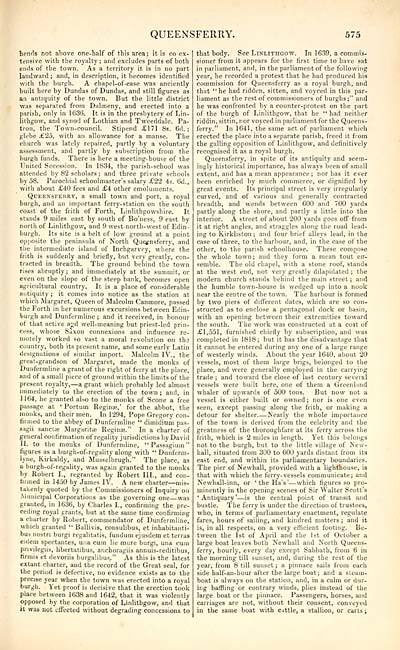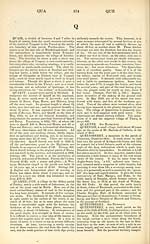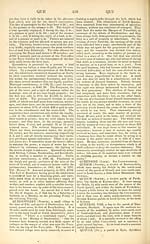Topographical, statistical, and historical gazetteer of Scotland > Volume 2
(591) Page 575
Download files
Complete book:
Individual page:
Thumbnail gallery: Grid view | List view

QUEENSFERRY.
575
hends not above one-half of this area; it is co-ex-
tensive with the royalty; and excludes parts of both
ends of the town. As a territory it is in no part
landward ; and, in description, it becomes identified
with the burgh. A chapel-of-ease was anciently
built here by Dundas of Dundas, and still figures as
an antiquity of the town. But the little district
was separated from Dalmeny, and erected into a
parish, only in 1636. It is in the presbytery of Lin-
lithgow, and synod of Lothian and Tweeddale. Pa-
tron, the Town-council. Stipend £171 8s. 6d. ;
glebe £25, with an allowance for a manse. The
church was lately repaired, partly by a voluntary
assessment, and partly by subscription from the
burgh funds. There is here a meeting-house of the
United Secession. In 1834, the parish-school was
attended by 82 scholars ; and three private schools
by 58. Parochial schoolmaster's salary £22 4s. 6d.,
with about £40 fees and £4 other emoluments.
Queensferry, a small town and port, a royal
burgh, and an important ferry-station on the south
coast of the frith of Forth, Linlithgowshire. It
stands 9 miles east by south of Bo'ness, 9 east by
north of Linlithgow, and 9 west-north-west of Edin-
burgh. Its site is a belt of low ground at a point
opposite the peninsula of North Queensferry, and
the intermediate island of Inchgarvey, where the
frith is suddenly and briefly, but very greatly, con-
tracted in breadth. The ground behind the town
rises abruptly; and immediately at the summit, or
even on the slope of the steep bank, becomes open
agricultural country. It is a place of considerable
antiquity ; it comes into notice as the station at
which Margaret, Queen of Malcolm Canmore, passed
the Forth in her numerous excursions between Edin-
burgh and Dunfermline ; and it received, in honour
of that active a^d well-meaning but priest-led prin-
cess, whose Saxon connexions and influence re-
motely worked so vast a moral revolution on the
country, both its present name, and some early Latin
designations of similar import. Malcolm IV., the
great-grandson of Margaret, made the monks of
Dunfermline a grant of the right of ferry at the place,
and of a small piece of ground within the limits of the
present royalty, — a grant which probably led almost
immediately to the erection of the town; and, in
1 164, he granted also to the monks of Scone a free
passage at ' Portum Reginse,' for the abbot, the
monks, and their men. In 1294, Pope Gregory con-
firmed to the abbey of Dunfermline " dimidium pas-
sagii sancta; Margarita? Beginae." In a charter of
general confirmation of regality jurisdictions by David
II. to the monks of Dunfermline, " Passagium "
figures as a burgh-of-regality along with " Dunferm-
lyne, Kirkaldy, and Musselbrugh." The place, as
a burgh-of-regality, was again granted to the monks
by Robert I., regranted by Robert III., and con-
firmed in 1450 by James IV. A new charter — mis-
takenly quoted by the Commissioners of Inquiry on
Municipal Corporations as the governing one — was
granted, in 1636, by Charles I., confirming the pre-
ceding royal grants, but at the same time confirming
a charter by Robert, commendator of Dunfermline,
which granted " Ballivis, consulibus, et inhabitanti-
bus nostn burgi regalitatis, fundum ejusdem et terras
eiilem spectantes, una cum lie mure burgi, una cum
privileges, libertatibus, anchoragiis annuis-reditibus,
iirmis et devoriis burgalibus." As this is the latest
extant charter, and the record of the Great seal, for
the period is defective, no evidence exists as to the
precise year when the town was erected into a royal
burgh. Yet proof is decisive that the erection took
place between 1638 and 1642, that it was violently
opposed by the corporation of Linlithgow, and that
it was not effected without degrading concessions to
that body. See Linlithgow. In 1639, a commis-
sioner from it appears for the first time to have sat
in parliament, and, in the parliament of the following
year, he recorded a protest that he had produced his
commission for Queensferry as a royal burgh, and
that "he had ridden, sitten, and voyced in this par-
liament as the rest of commissioners of burghs;" and
be was confronted by a counter-protest on the part
of the burgh of Linlithgow, that he " had neither
riddin, sittin, nor voyced in parliament for the Queens-
ferry." In 1641, the same act of parliament which
erected the place into a separate parish, freed it from
the galling opposition of Linlithgow, and definitively
recognised it as a royal burgh.
Queensferry, in spite of its antiquity and seem-
ingly historical importance, has always been of small
extent, and has a mean appearance; nor has it ever
been enriched by much commerce, or dignified by
great events. Its principal street is very irregularly
curved, and of various and generally contracted
breadth, and wends between 600 and 700 yards
partly along the shore, and partly a little into the
interior. A street of about 200 yards goes off from
it at right angles, and straggles along the road lead-
ing to Kirkliston ; and four brief alleys lead, in the
case of three, to the harbour, and, in the case of the
other, to the parish schoolhouse. These compose
the whole town ; and they form a mean tout en-
semble. The old chapel, with a stone roof, stands
at the west end, not very greatly dilapidated ; the
modern church stands behind the main street ; and
the humble town-house is wedged up into a nook
near the centre of the town. The harbour is formed
by two piers of different dates, which are so con-
structed as to enclose a pentagonal dock or basin,
with an opening between their extremities toward
the south. The work was constructed at a cost of
£1,551, furnished chiefly by subscription, and was
completed in 1818; but it has the disadvantage that
it cannot be entered during any one of a large range
of westerly winds. About the year 1640, about 20
vessels, most of them large brigs, belonged to the
place, and were generally employed in the carrying
trade ; and toward the close of last century several
vessels were built here, one of them a Greenland
whaler of upwards of 500 tons. But now not a
vessel is either built or owned; nor is one even
seen, except passing along the frith, or making a
detour for shelter Nearly the whole importance
of the town is derived from the celebrity and the
greatness of the thoroughfare at its ferry across the
frith, which is 2 miles in length. Yet this belongs
not to the burgh, but to the little village of New-
hall, situated from 300 to 600 yards distant from its
east end, and within its parliamentary boundaries.
The pier of Newhall, provided with a lighthouse, is
that with which the ferry-vessels communicate; and
Newhall-inn, or l theHaV — which figures so pro-
minently in the opening scenes of Sir Walter Scott's
'Antiquary' — is the central point of transit and
bustle. The ferry is under the direction of trustees,
who, in terms of parliamentary enactment, regulate
fares, hours of sailing, and kindred matters ; and it
is, in all respects, on a very efficient footing. Be-
tween the 1st of April and the 1st of October a
large boat leaves both Newhall and North Queens-
ferry, hourly, every day except Sabbath, from 6 in
the morning till sunset, and, during the rest of the
year, from 8 till sunset ; a pinnace sails from each
side half-an-hour after the large boat; and a steam-
boat is always on the station, and, in a calm or dur-
ing baffling or contrary winds, plies instead of the
large boat or the pinnace. Passengers, horses, and
carriages are not, without their consent, conveyed
in the same boat with cattle, a stallion, or carts ;
575
hends not above one-half of this area; it is co-ex-
tensive with the royalty; and excludes parts of both
ends of the town. As a territory it is in no part
landward ; and, in description, it becomes identified
with the burgh. A chapel-of-ease was anciently
built here by Dundas of Dundas, and still figures as
an antiquity of the town. But the little district
was separated from Dalmeny, and erected into a
parish, only in 1636. It is in the presbytery of Lin-
lithgow, and synod of Lothian and Tweeddale. Pa-
tron, the Town-council. Stipend £171 8s. 6d. ;
glebe £25, with an allowance for a manse. The
church was lately repaired, partly by a voluntary
assessment, and partly by subscription from the
burgh funds. There is here a meeting-house of the
United Secession. In 1834, the parish-school was
attended by 82 scholars ; and three private schools
by 58. Parochial schoolmaster's salary £22 4s. 6d.,
with about £40 fees and £4 other emoluments.
Queensferry, a small town and port, a royal
burgh, and an important ferry-station on the south
coast of the frith of Forth, Linlithgowshire. It
stands 9 miles east by south of Bo'ness, 9 east by
north of Linlithgow, and 9 west-north-west of Edin-
burgh. Its site is a belt of low ground at a point
opposite the peninsula of North Queensferry, and
the intermediate island of Inchgarvey, where the
frith is suddenly and briefly, but very greatly, con-
tracted in breadth. The ground behind the town
rises abruptly; and immediately at the summit, or
even on the slope of the steep bank, becomes open
agricultural country. It is a place of considerable
antiquity ; it comes into notice as the station at
which Margaret, Queen of Malcolm Canmore, passed
the Forth in her numerous excursions between Edin-
burgh and Dunfermline ; and it received, in honour
of that active a^d well-meaning but priest-led prin-
cess, whose Saxon connexions and influence re-
motely worked so vast a moral revolution on the
country, both its present name, and some early Latin
designations of similar import. Malcolm IV., the
great-grandson of Margaret, made the monks of
Dunfermline a grant of the right of ferry at the place,
and of a small piece of ground within the limits of the
present royalty, — a grant which probably led almost
immediately to the erection of the town; and, in
1 164, he granted also to the monks of Scone a free
passage at ' Portum Reginse,' for the abbot, the
monks, and their men. In 1294, Pope Gregory con-
firmed to the abbey of Dunfermline " dimidium pas-
sagii sancta; Margarita? Beginae." In a charter of
general confirmation of regality jurisdictions by David
II. to the monks of Dunfermline, " Passagium "
figures as a burgh-of-regality along with " Dunferm-
lyne, Kirkaldy, and Musselbrugh." The place, as
a burgh-of-regality, was again granted to the monks
by Robert I., regranted by Robert III., and con-
firmed in 1450 by James IV. A new charter — mis-
takenly quoted by the Commissioners of Inquiry on
Municipal Corporations as the governing one — was
granted, in 1636, by Charles I., confirming the pre-
ceding royal grants, but at the same time confirming
a charter by Robert, commendator of Dunfermline,
which granted " Ballivis, consulibus, et inhabitanti-
bus nostn burgi regalitatis, fundum ejusdem et terras
eiilem spectantes, una cum lie mure burgi, una cum
privileges, libertatibus, anchoragiis annuis-reditibus,
iirmis et devoriis burgalibus." As this is the latest
extant charter, and the record of the Great seal, for
the period is defective, no evidence exists as to the
precise year when the town was erected into a royal
burgh. Yet proof is decisive that the erection took
place between 1638 and 1642, that it was violently
opposed by the corporation of Linlithgow, and that
it was not effected without degrading concessions to
that body. See Linlithgow. In 1639, a commis-
sioner from it appears for the first time to have sat
in parliament, and, in the parliament of the following
year, he recorded a protest that he had produced his
commission for Queensferry as a royal burgh, and
that "he had ridden, sitten, and voyced in this par-
liament as the rest of commissioners of burghs;" and
be was confronted by a counter-protest on the part
of the burgh of Linlithgow, that he " had neither
riddin, sittin, nor voyced in parliament for the Queens-
ferry." In 1641, the same act of parliament which
erected the place into a separate parish, freed it from
the galling opposition of Linlithgow, and definitively
recognised it as a royal burgh.
Queensferry, in spite of its antiquity and seem-
ingly historical importance, has always been of small
extent, and has a mean appearance; nor has it ever
been enriched by much commerce, or dignified by
great events. Its principal street is very irregularly
curved, and of various and generally contracted
breadth, and wends between 600 and 700 yards
partly along the shore, and partly a little into the
interior. A street of about 200 yards goes off from
it at right angles, and straggles along the road lead-
ing to Kirkliston ; and four brief alleys lead, in the
case of three, to the harbour, and, in the case of the
other, to the parish schoolhouse. These compose
the whole town ; and they form a mean tout en-
semble. The old chapel, with a stone roof, stands
at the west end, not very greatly dilapidated ; the
modern church stands behind the main street ; and
the humble town-house is wedged up into a nook
near the centre of the town. The harbour is formed
by two piers of different dates, which are so con-
structed as to enclose a pentagonal dock or basin,
with an opening between their extremities toward
the south. The work was constructed at a cost of
£1,551, furnished chiefly by subscription, and was
completed in 1818; but it has the disadvantage that
it cannot be entered during any one of a large range
of westerly winds. About the year 1640, about 20
vessels, most of them large brigs, belonged to the
place, and were generally employed in the carrying
trade ; and toward the close of last century several
vessels were built here, one of them a Greenland
whaler of upwards of 500 tons. But now not a
vessel is either built or owned; nor is one even
seen, except passing along the frith, or making a
detour for shelter Nearly the whole importance
of the town is derived from the celebrity and the
greatness of the thoroughfare at its ferry across the
frith, which is 2 miles in length. Yet this belongs
not to the burgh, but to the little village of New-
hall, situated from 300 to 600 yards distant from its
east end, and within its parliamentary boundaries.
The pier of Newhall, provided with a lighthouse, is
that with which the ferry-vessels communicate; and
Newhall-inn, or l theHaV — which figures so pro-
minently in the opening scenes of Sir Walter Scott's
'Antiquary' — is the central point of transit and
bustle. The ferry is under the direction of trustees,
who, in terms of parliamentary enactment, regulate
fares, hours of sailing, and kindred matters ; and it
is, in all respects, on a very efficient footing. Be-
tween the 1st of April and the 1st of October a
large boat leaves both Newhall and North Queens-
ferry, hourly, every day except Sabbath, from 6 in
the morning till sunset, and, during the rest of the
year, from 8 till sunset ; a pinnace sails from each
side half-an-hour after the large boat; and a steam-
boat is always on the station, and, in a calm or dur-
ing baffling or contrary winds, plies instead of the
large boat or the pinnace. Passengers, horses, and
carriages are not, without their consent, conveyed
in the same boat with cattle, a stallion, or carts ;
Set display mode to: Large image | Transcription
Images and transcriptions on this page, including medium image downloads, may be used under the Creative Commons Attribution 4.0 International Licence unless otherwise stated. ![]()
| Gazetteers of Scotland, 1803-1901 > Topographical, statistical, and historical gazetteer of Scotland > Volume 2 > (591) Page 575 |
|---|
| Permanent URL | https://digital.nls.uk/97455682 |
|---|
| Description | Volume second: I-Z. |
|---|---|
| Shelfmark | Map Room Ref.2 |
| Attribution and copyright: |
|

